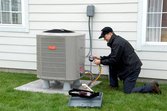If you installed an energy-tax-credit-eligible heating and cooling system, here’s what you need to do to collect.
The Feds allow a suite of energy tax credits for heating and cooling systems and related energy-efficiency improvements.
Read on to learn more.
The Basics
- Lifetime credit max of 10% of costs, up to $500 for all energy improvements combined.
- File IRS Form 5695 with your returns. This can be tricky, so pay attention to the details.
- You must have installed a relevant heating and cooling system by Dec. 31, 2016.
- Save manufacturer certifications and receipts in case you need them for filing.
Although there is a $500 overall ceiling, some improvements have individual limits below $500:
- $50 for any advanced main air-circulating fan.
- $150 for any qualified natural gas, propane, or oil furnace or hot water boiler.
- $300 for any qualified item of energy-efficient building property, as specified by the IRS. In previous guidance, this category included certain approved electric and geothermal heat pumps, central air conditioning systems, and natural gas, propane, or oil water heaters.
The Energy Star site has guidelines on what heating and cooling systems are covered. It’s your safest bet for information on which kinds of systems and individual products get you the credit.
Don’t rely solely on contractors who may not know the details of the energy tax credit program or who promise their products will get the credit in order to make a sale.
What Efficiency Means to Your Wallet
The tax credit makes it a little easier to do what you should do anyway. Upgrading your heating, ventilation, and air conditioning (HVAC) to energy-efficient units can cut utility costs by about 20%, or $200 annually, on average.
However, you need cash to get going — these upgrades aren’t cheap. Although prices vary, keep in mind that:
- A high-efficiency furnace starts around $3,500, including installation, estimates Corbett Lunsford, executive director of Chicago-based Green Dream Group, an energy-efficiency and eco-consulting firm.
- A standard furnace may cost $2,400.
Not All Heating and Cooling Systems Qualify for Tax Credit
Not even every product with an Energy Star rating will get you the tax credit. Energy Star-rated furnaces must be more efficient than standard units, with annual fuel utilization efficiency ratings (AFUE) of:
- 85% for oil furnaces
- 90% for gas furnaces
AFUE ratings must be higher for credit-eligible furnaces:
- Gas (either natural gas or propane): 95%
- Oil: 95%
Boilers must have an AFUE of 95%.
Central air-conditioners:
Split Systems:
- SEER>= 16
- EER >= 13
Package systems:
- SEER >= 14
- EER >= 12
Note: Energy Star may update these criteria at any time, so check online before making a purchase.
Payback and Benefits of HVAC Replacement
It typically takes about a decade’s worth of energy savings to recoup the investment in a new HVAC system, Dream Group’s Lunsford says, though that time frame can vary greatly depending on fuel price fluctuations.
Less apparent in dollar terms — but still valuable — is the increasing comfort level in your home and lowering your household’s drain on non-renewable fossil fuels.
You’ll get a bump up in salability when you’re ready to move on, says Frank Lesh, president of Home Sweet Home Inspection Co. in Indian Head Park, Ill. That doesn’t mean adding a $5,000 furnace will add $5,000 to the sale price. Rather, potential buyers are less likely to push for repairs or negotiate a credit if the HVAC is in good shape.
But before you do, conduct an energy audit of your home. Lunsford, also manager of consumer education for the U.S. Green Building Council’s Chicago Chapter, says he rarely recommends replacing a furnace as the first step in making a home more energy efficient.
Start by sealing it against air leaks:
- Do-it-yourself caulking and weatherstripping help, as does adding insulation in the attic.
- Professional air sealing, which is more effective, can cost as much as $5,000 for a large house, he says.
The payoff: Energy costs should go down, and you might get by with a smaller HVAC system.




